Cacciucco – Tuscan Seafood Stew
Cacciucco is more than a seafood stew—it’s a living memory of Tuscany’s coastal heritage, born in the port city of Livorno and rooted in the humble traditions of fishermen.
A rustic, robust dish layered with the essence of the sea, Cacciucco celebrates variety and depth—melding tender octopus, briny clams, and delicate white fish into a tomato-rich broth infused with wine, garlic, and sage.
The soul of this stew lies in its slow simmer and thoughtful assembly, building flavor over time and finishing with a flourish of fresh herbs over garlic-rubbed toasted bread. It’s a dish meant to be savored slowly, shared generously, and remembered deeply.
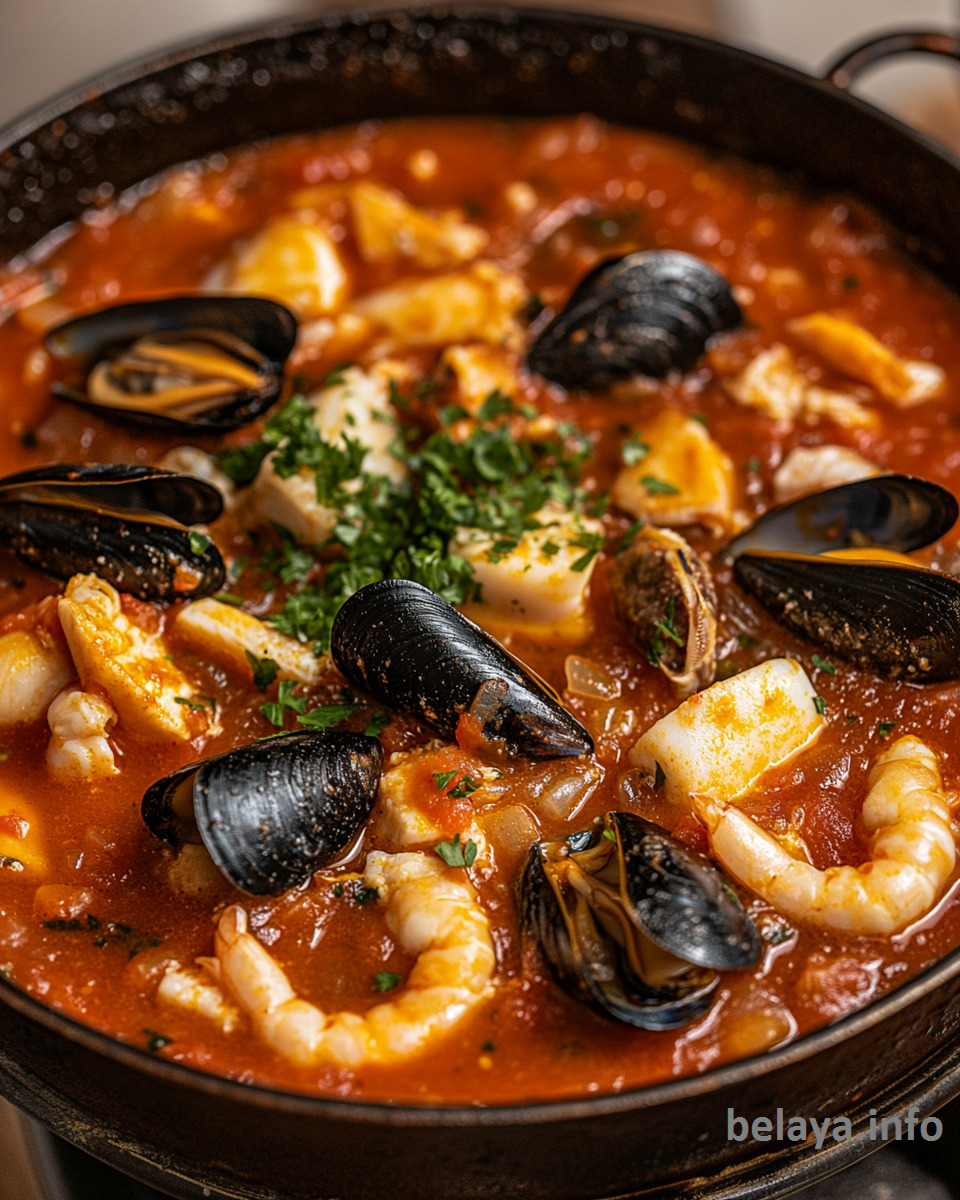
Why People Will Love The Cacciucco – Tuscan Seafood Stew:
Rich with coastal tradition: This dish is a taste of Tuscany’s maritime history, blending generations of rustic Italian cooking with the soul of the sea—each spoonful tells a story of fishermen, port towns, and centuries-old technique.
Layered, complex flavors: From the slow-simmered octopus and squid to the wine-reduced tomato base, every element adds depth. The combination of roasted garlic, aromatic herbs, and fresh seafood creates a broth that’s both bold and refined.
Incredible seafood variety: With clams, mussels, langoustines, white fish, and more, the stew delivers a complete spectrum of textures and flavors—from briny to buttery, delicate to hearty.
Elegant yet rustic presentation: Served over garlic-rubbed toasted bread and finished with parsley, Cacciucco is visually striking and texturally satisfying—a comforting yet elevated dish fit for both homey dinners and special occasions.
A dish that rewards patience: The long simmering process and careful layering make it more than a meal—it becomes a ritual. People will love not just the final flavor, but the journey to get there.
Perfect for sharing: Cacciucco is made to gather people. Whether for a celebratory meal or a cozy evening, it encourages slow eating, good wine, and warm conversation.
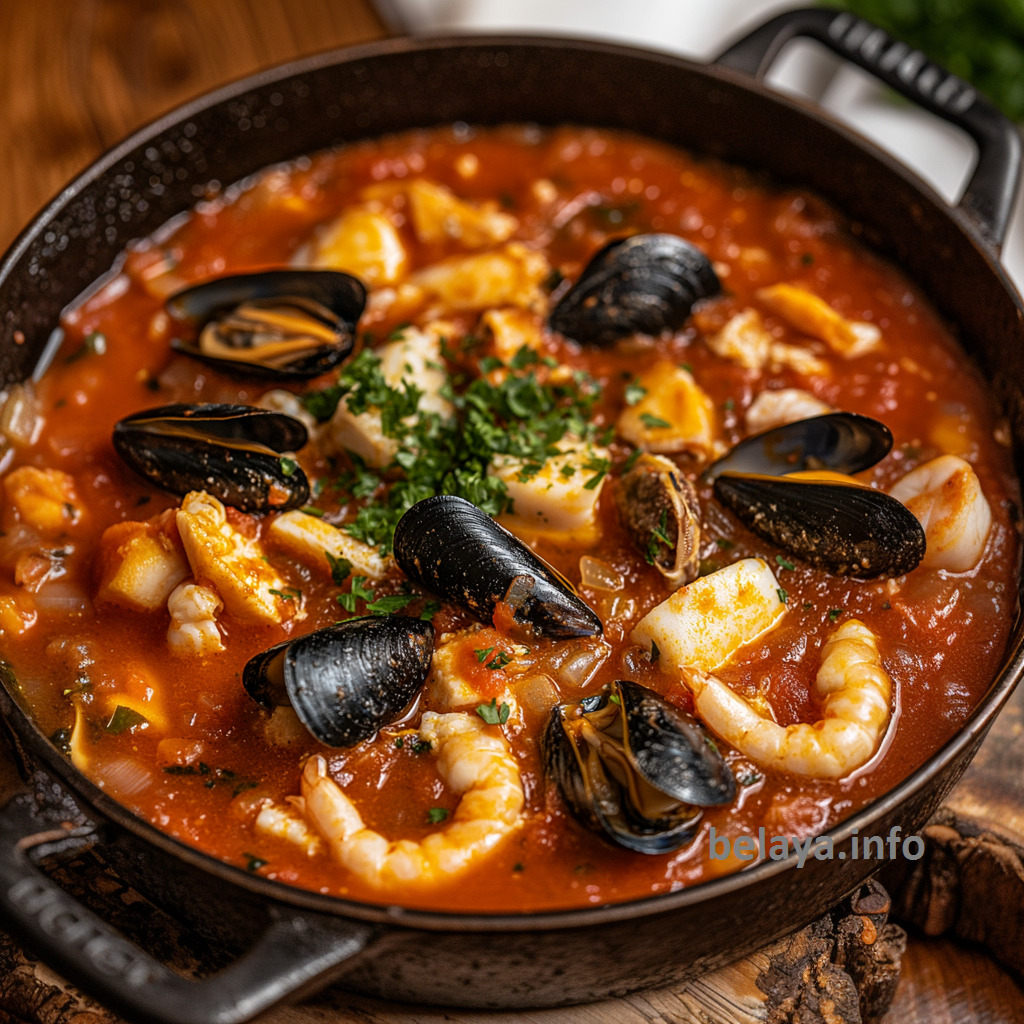
Key Ingredients:
Octopus and squid bring depth and richness to the stew’s base. When simmered slowly, they release umami-packed juices that form the foundation of the broth, adding a meaty texture that anchors the lighter shellfish to come.
Fresh shellfish—clams, mussels, and langoustines— deliver a burst of briny sweetness and ocean-fresh flavor. Their natural juices enrich the broth as they steam open, adding complexity and fragrance.
Firm white fish like monkfish, gurnard, and red snapper offer contrasting textures—from buttery to flaky—and absorb the stew’s bold tomato and wine base while remaining intact during cooking.
Red wine and passata form the heart of the sauce, adding body, acidity, and warmth. The wine lends a subtle depth, while the passata gives the stew its rustic, vibrant character.
Aromatics like garlic, onion, celery, fennel seeds, and sage create the stew’s backbone, layering sweetness, herbaceousness, and a touch of licorice-like perfume that complements the richness of the seafood.
Toasted garlic-rubbed bread isn’t just a side—it’s tradition. It absorbs the broth’s essence and grounds the dish with rustic comfort, turning every bite into a full sensory experience.
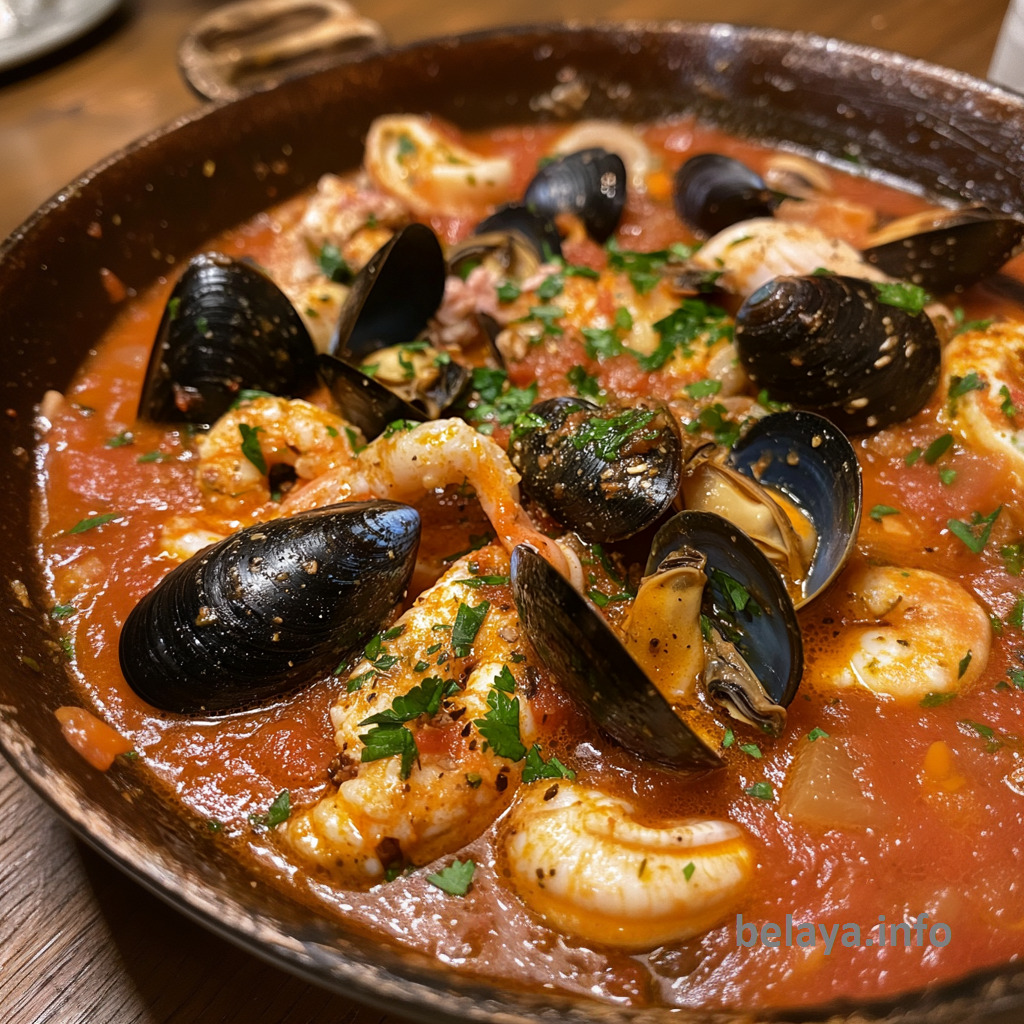
Expert Tips:
Use a wide, heavy pot for even cooking:
A broad base allows you to layer ingredients without overcrowding, helping seafood cook evenly and giving aromatics room to release their flavors properly.
Cook seafood in stages:
Don’t rush by adding all seafood at once. Start with tougher proteins like octopus and squid, which need time to tenderize. More delicate fish and shellfish should be added near the end to preserve their texture and prevent overcooking.
Simmer, don’t boil:
Once the stew base is assembled, maintain a low simmer. Boiling will toughen seafood and muddy the flavors, while a gentle simmer coaxes out nuance and tenderness.
Deglaze with quality wine:
The red wine is more than liquid—it’s a key flavor note. Choose a dry, medium-bodied Italian red (like Chianti) to enrich the base and complement the seafood without overpowering it.
Broth is your canvas—season gradually:
The fish stock carries the stew’s essence. Add it in stages to control thickness and flavor intensity, tasting often to strike the perfect balance of richness and brightness.
Do not overstir after adding the fish:
Firm fish will flake apart if stirred too much. Let them poach undisturbed to retain their structure and presentation in the final dish.
Steam and scrub shellfish thoroughly:
Ensure clams and mussels are clean and live before cooking. Soak in salted water and scrub well to avoid grit. Discard any that don’t open during cooking to ensure safety and quality.
Infuse the bread properly:
Rub toasted slices of rustic bread with raw garlic while still warm. The bread absorbs the stew’s broth beautifully, providing both texture and an earthy, aromatic base.
Finish with brightness:
A final sprinkle of fresh parsley and a drizzle of extra virgin olive oil just before serving lifts the dish, adding color and a fresh contrast to the stew’s rich, slow-simmered depth.
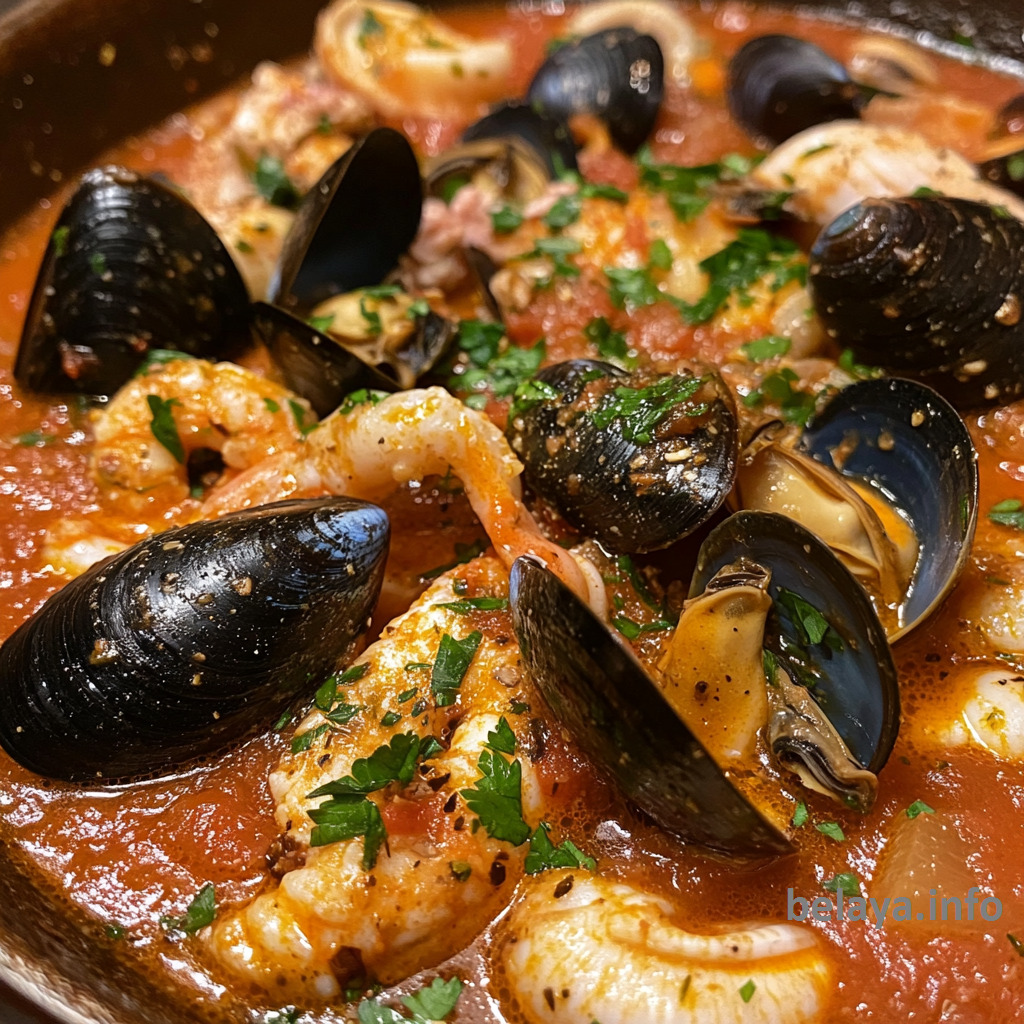
Cacciucco – Tuscan seafood stew
Ingredients:
3 tbsp of olive oil
1 pinch of chilli flakes
1 pinch of fennel seeds
4 garlic cloves, finely minced
1 onion, finely diced
1 celery stick, finely diced
1 small octopus, cleaned and sliced
squid, small, cleaned and sliced into rings
250ml of red wine
2 sprigs of sage
400ml of passata
1l fish stock
salt
pepper
FISH AND SEAFOOD
200g of clams, cleaned
200g of mussels, cleaned
6 langoustines
200g of monkfish tail, cut into 6 pieces
200g of gurnard, cut into 6 pieces
200g of red snapper fillet, cut into 6 pieces
TO FINISH
6 slices of bread, toasted
2 garlic cloves
parsley, chopped
Instructions:
Step 1: Sauté the aromatics
Heat 2 tablespoons of olive oil in a large, heavy-bottomed pot over medium heat.
Add the chili flakes and fennel seeds, then stir in the finely diced onion, garlic, and celery along with a pinch of salt.
Cook gently until the vegetables are soft and fragrant, but not browned.
Step 2: Sear the octopus and squid
Remove the sautéed vegetables from the pan and set aside.
Increase the heat to medium-high.
Add the remaining 1 tablespoon of olive oil, followed by the octopus and squid.
Sauté until the seafood begins to release its liquid and most of it has evaporated.
Step 3: Deglaze and simmer
Return the cooked vegetables to the pot.
Pour in the red wine and add the sage sprigs.
Allow the mixture to simmer and reduce by half, concentrating the flavor.
Stir in the passata and 600 ml of the fish stock.
Reduce the heat to low and simmer gently for about 1 hour, stirring occasionally, until the octopus becomes tender.
Step 4: Add firm fish and langoustines
Pour in the remaining 400 ml of fish stock to slightly thin the stew.
Gently add the monkfish, gurnard, and red snapper pieces.
Avoid over-stirring to prevent the fish from falling apart.
Nestle the langoustines into the stew, cover with a lid, and simmer for 5 minutes.
Step 5: Add shellfish
Remove the lid and scatter in the cleaned mussels and clams.
Cover again and cook for 3–4 more minutes, or until the shells have opened.
Discard any shellfish that do not open.
Step 6: Serve
Ladle the stew over slices of toasted bread rubbed with raw garlic.
Finish with a generous sprinkle of chopped fresh parsley and serve hot.
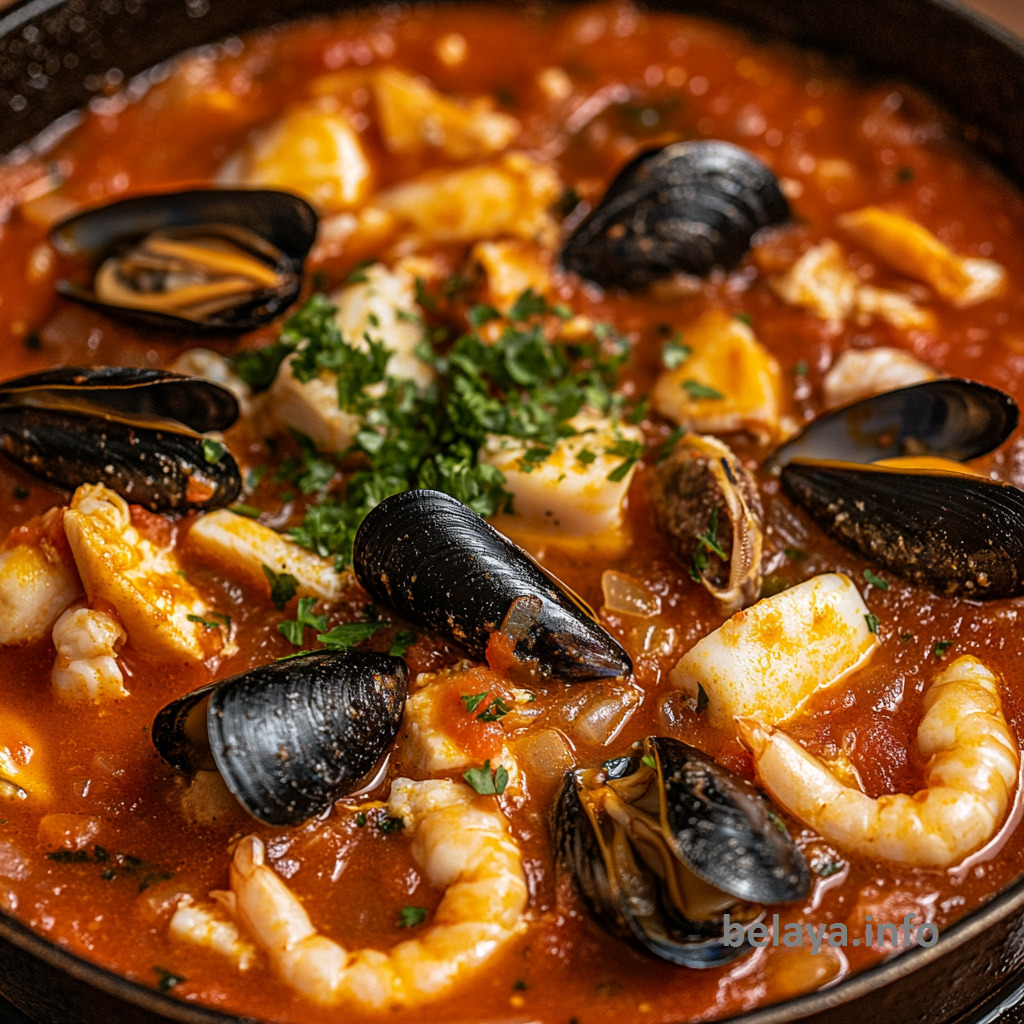
Important Notes When Making Cacciucco – Tuscan Seafood Stew:
Respect the timing and order of ingredients:
The soul of Cacciucco lies in its layered construction. Tougher seafood like octopus and squid must be simmered gently for an hour to tenderize, while delicate fish and shellfish are added at the end to retain their integrity and freshness. This sequence is key to achieving proper texture and balanced flavor.
Quality of seafood defines the dish:
Freshness is non-negotiable. The stew relies entirely on the natural flavors of the sea, so choose high-quality, sustainable seafood. A mix of textures—from firm-fleshed fish to soft mollusks—is essential for a true Cacciucco experience.
Use real fish stock, not water:
Authentic flavor comes from a rich, homemade or high-quality fish stock. Water dilutes the body of the stew and weakens the depth created by the roasted vegetables, wine, and seafood.
Bread is part of the experience, not just a side:
The toasted garlic-rubbed bread serves a dual purpose—it absorbs the broth and completes the dish. It’s how Cacciucco is traditionally eaten, echoing the humble, rustic origins of Tuscan cucina povera.
Red wine isn’t optional—it’s foundational:
The wine adds acidity, depth, and a slight tannic edge that balances the sweetness of the tomatoes and shellfish. Choose a dry Italian red with earthy notes, such as Chianti or Sangiovese, to stay true to its Tuscan roots.
Simmer gently and be patient:
Like many stews rooted in tradition, this dish rewards slow cooking. Allowing time for flavors to meld and ingredients to release their essence is what transforms simple components into a cohesive, luxurious broth.
Don’t overpower the seafood:
Avoid over-seasoning or using overly spicy peppers. The subtle sweetness of the shellfish and richness of the fish should shine through—enhanced, not masked, by the aromatics and herbs.
Cacciucco improves with rest:
If time allows, let the stew sit for an hour off the heat before serving—or make it a few hours ahead. Resting helps the flavors deepen and meld beautifully.
How to Enjoy Cacciucco After Cooking
Serve it the traditional way:
Ladle the stew generously over garlic-rubbed, toasted rustic bread placed at the bottom of a bowl. This bread absorbs the rich, briny broth and becomes an essential part of the experience—soft, flavorful, and deeply satisfying.
Pair it with a Tuscan red wine:
A glass of Chianti, Morellino di Scansano, or Rosso di Montalcino perfectly complements the acidity of the tomatoes and the sea-salt essence of the stew. The wine’s earthiness enhances the stew’s depth without overwhelming the delicate seafood.
Add fresh finishing touches:
Just before serving, garnish with fresh chopped parsley, a drizzle of extra virgin olive oil, or even a few drops of lemon juice to brighten the richness and elevate the aromatics.
Turn it into a full-course experience:
Begin with a light Tuscan salad or grilled vegetables, follow with Cacciucco as the centerpiece, and finish with a simple panna cotta or biscotti with vin santo to round out the meal in authentic Italian fashion.
Enjoy leftovers thoughtfully:
If you have leftovers, reheat the base gently—remove any shellfish beforehand to prevent overcooking and add them back in at the end. Serve with fresh toasted bread to recreate the texture and richness of the original meal.
Serve family-style:
Present the stew in a large pot at the center of the table with bowls of toasted bread, lemon wedges, and wine on the side. This communal approach celebrates the dish’s rustic roots and invites sharing.
Nutrition Information for Cacciucco – Tuscan Seafood Stew:
Based on approximately 6 servings (each including a slice of garlic-rubbed toasted bread):
Calories: 420 kcal | Total Fat: 14.1 g | Saturated Fat: 2.4 g | Monounsaturated Fat: 8.2 g | Polyunsaturated Fat: 1.9 g | Cholesterol: 165 mg | Sodium: 780–900 mg (depending on added salt and seafood) | Total Carbohydrates: 20.6 g | Dietary Fiber: 3.1 g | Sugars: 6.2 g | Protein: 45.8 g
Frequently Asked Questions:
Can I use frozen seafood instead of fresh?
Yes, you can use frozen seafood, but for the best flavor and texture, it should be fully thawed and drained before use.
Make sure to pat dry the seafood to prevent excess water from diluting the stew, and avoid overcooking to preserve tenderness.
What type of fish works best in Cacciucco if I can’t find monkfish or gurnard?
You can substitute with any firm white fish that holds its shape well when simmered, such as cod, halibut, haddock, or sea bass.
Avoid delicate fish like sole, as they may fall apart in the stew.
Do I have to use wine in this recipe?
Red wine is traditional and adds depth and acidity that balances the tomato and seafood flavors.
However, if you prefer to omit alcohol, you can substitute with a mix of fish stock and a splash of red wine vinegar or lemon juice to mimic the acidity.
What should I do if my shellfish doesn’t open after cooking?
Any mussels or clams that don’t open after 3–4 minutes of steaming should be discarded, as they may not be safe to eat.
Be sure to rinse and scrub all shellfish before cooking to ensure freshness and food safety.
How can I make this dish ahead of time without overcooking the seafood?
You can prepare the base of the stew (with squid, octopus, passata, wine, and aromatics) a day in advance.
When ready to serve, reheat the base gently and add the delicate seafood—fish, langoustines, mussels, and clams—at the very end to cook them fresh and retain ideal texture.
Why do I cook the octopus and squid separately from the rest of the seafood?
Octopus and squid need longer, slower cooking to become tender.
Cooking them first allows their flavors to infuse the base without turning rubbery, while more delicate fish and shellfish are added later to prevent overcooking.
Can I skip the step of reducing the wine and stock before adding fish?
No—reducing the wine and initial stock is essential for developing depth and richness in the stew.
This concentrates flavors and thickens the base so it can carry the full weight of the seafood without tasting watery.
How do I keep the fish from falling apart in the stew?
Use firm, skinless white fish, and add it toward the end of cooking.
Once in the pot, avoid stirring too much—let the fish poach gently so it retains its shape and texture.
Should I peel the squid and octopus before cooking?
It’s not required, but removing the thin outer membrane from squid and octopus (if not already cleaned) can help achieve a smoother texture and cleaner appearance.
Most fishmongers will clean them for you if requested.
What’s the best way to toast the bread for serving?
Use thick slices of rustic bread, toast them until crisp on both sides, then rub with raw garlic while still hot.
This infuses the bread with flavor and creates the traditional base for ladling the stew—a signature element of authentic Cacciucco.